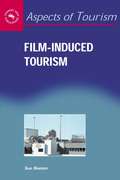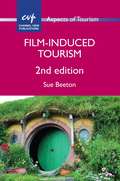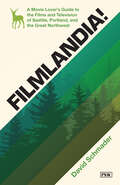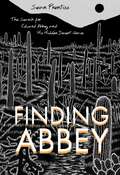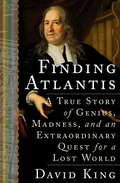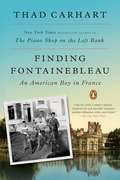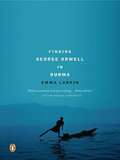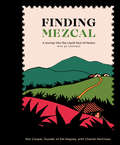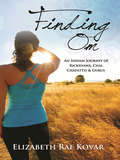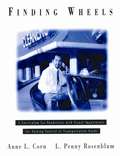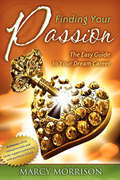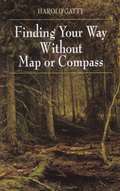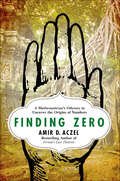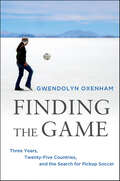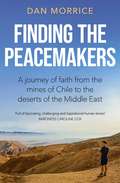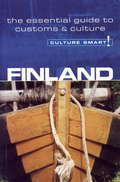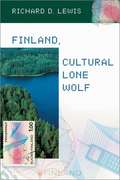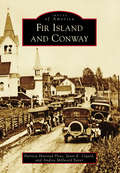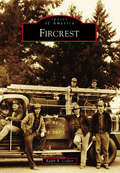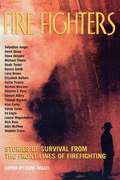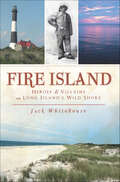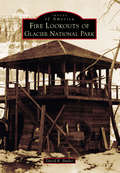- Table View
- List View
Film-Induced Tourism
by Sue BeetonFilm-induced tourism has the potential to revitalise flagging regional/rural communities and increase tourism to urban centres, however it carries with it its own unique problems. This publication explores such elements, delving into the disciplines of sociology and psychology, along with the fields of destination marketing, community development and strategic planning.
Film-Induced Tourism: 2nd edition
by Sue BeetonThis research-based monograph presents an introduction to the concept of film-induced tourism, building on the work of the seminal first edition. Many new case studies exploring the relationship between film and TV and tourism have been added and existing cases have been updated. The book incorporates studies on film studio theme parks, the impact of film-induced tourism on communities and the effect of film on tourists' behaviour. It introduces new content including film-induced tourism in non-Western cultures, movie tours and contents tourism. The book is an essential resource for postgraduate students and researchers in the fields of tourism, film and media studies.
Filmlandia!: A Movie Lover's Guide to the Films and Television of Seattle, Portland, and the Great Northwest
by David SchmaderFrom Twin Peaks to Twilight, from Practical Magic to Portlandia!, Filmlandia! highlights more than 200 film and television entertainments created and centered in Seattle, Portland, and the greater Pacific Northwest, extensively researched and curated by culture writer David Schmader.The PNW has a thriving, rich film culture, and it's finally celebrated in a guide as visually arresting and compelling as the films and television themselves!More than 200 entries are included and feature:• Hilarious, insightful synopses• Behind-the-scene facts and trivia• Regional scenic highlightsIn addition, sidebars pepper the pages, covering:• Regional filmmakers like Gus Van Sant and Lynn Shelton• Television shows that shaped the public's perception of the region (such as Twin Peaks, Shrill, and Portlandia!)• Documentaries, queer cinema, silent films, Vancouver-shot imposters, and more. Colorful artwork, inspired by the primary VHS color palette of the 80s, turns this handy guide into a visual treat as well. This is a book for any cinephile, but for those who love and live in the PNW, Filmlandia! is an absolute must-have.
Finding Abbey: The Search for Edward Abbey and His Hidden Desert Grave
by Sean PrentissWhen the great environmental writer Edward Abbey died in 1989, four of his friends buried him secretly in a hidden desert spot that no one would ever find. The final resting place of the Thoreau of the American West remains unknown and has become part of American folklore. In this book a young writer who went looking for Abbey&’s grave combines an account of his quest with a creative biography of Abbey.Sean Prentiss takes readers across the country as he gathers clues from his research, travel, and interviews with some of Abbey&’s closest friends—including Jack Loeffler, Ken &“Seldom Seen&” Sleight, David Petersen, and Doug Peacock. Along the way, Prentiss examines his own sense of rootlessness as he attempts to unravel Abbey&’s complicated legacy, raising larger questions about the meaning of place and home.
Finding Atlantis: A True Story of Genius, Madness, and an Extraordinary Quest for a Lost World
by David KingIn 1679, Renaissance man Olof Rudbeck stunned the world. He proposed that an ancient lost civilization once thrived in the far north of his native Sweden: the fabled Atlantis. Rudbeck would spend the last thirty years of his life hunting for the evidence that would prove this extraordinary theory. Chasing down clues to that lost golden age, Rudbeck combined the reasoning of Sherlock Holmes with the daring of Indiana Jones. He excavated what he thought was the acropolis of Atlantis, retraced the journeys of classical heroes, opened countless burial mounds, and consulted rich collections of manuscripts and artifacts. He eventually published his findings in a 2,500-page tome titled Atlantica, a remarkable work replete with heroic quests, exotic lands, and fabulous creatures. Three hundred years later, the story of Rudbeck's adventures appears in English for the first time. It is a thrilling narrative of discovery as well as a cautionary tale about the dangerous dance of genius and madness.
Finding Fontainebleau: An American Boy in France
by Thad CarhartA beguiling memoir of a childhood in 1950s Fontainebleau from the much-admired New York Times bestselling author of The Piano Shop on the Left Bank For a young American boy in the 1950s, Fontainebleau was a sight both strange and majestic, home to a continual series of adventures: a different language to learn, weekend visits to nearby Paris, family road trips to Spain and Italy. Then there was the château itself: a sprawling palace once the residence of kings, its grounds the perfect place to play hide-and-seek. The curiosities of the small town and the time with his family as expats left such an impression on him that thirty years later Carhart returned to France with his wife to raise their two children. Touring Fontainebleau again as an adult, he began to appreciate its influence on French style, taste, art, and architecture. Each trip to Fontainebleau introduces him to entirely new aspects of the château's history, enriching his memories and leading him to Patrick Ponsot, the head of the château's restoration, who becomes Carhart's guide to the hidden Fontainebleau. What emerges is an intimate chronicle of a time and place few have experienced. In warm, precise prose, Carhart reconstructs the wonders of his childhood as an American in postwar France, attending French schools with his brothers and sisters. His firsthand account brings to life nothing less than France in the 1950s, from the parks and museums of Paris to the rigors of French schooling to the vast château of Fontainebleau and its village, built, piece by piece, over many centuries. Finding Fontainebleau is for those captivated by the French way of life, for armchair travelers, and for anyone who has ever fallen in love with a place they want to visit over and over again.From the Hardcover edition.
Finding George Orwell in Burma: Travels In A Police State
by Emma LarkinA brave and revelatory reconnaissance of modern Burma using the life and work of George Orwell as its compass.
Finding Mezcal: A Journey into the Liquid Soul of Mexico, with 40 Cocktails
by Chantal Martineau Ron CooperIn this groundbreaking and deeply personal book, Ron Cooper--a leading voice in the artisanal mezcal movement, and the person largely responsible for popularizing the spirit in the United States--shares everything he knows about this storied, culturally rich, and now hugely in-demand spirit, along with 40 recipes.In 1990, artist Ron Cooper was collaborating with craftspeople in Oaxaca, Mexico, when he found mezcal--or, as he likes to say, mezcal found him. This traditional spirit was virtually unknown in the United States at the time, and Cooper founded Del Maguey Single Village Mezcal in order to import it. Finding Mezcal recounts Cooper's love affair with the spirit and the people who make it; its meteoric rise in popularity; and the delicate balance between sharing mezcal with the world and facilitating its preservation. Each chapter introduces a new mezcal, its producer, and its place of origin, while also covering mezcal production methods and the botany of the maguey (aka agave) plant, from which mezcal is distilled. Featuring 40 recipes developed for Del Maguey by chefs and bartenders from around the world, the book is copiously illustrated with photographs, as well as Cooper's artwork and that of his friend Ken Price, who illustrated Del Maguey's now-iconic labels.
Finding Om: An Indian Journey of Rickshaws, Chai, Chapattis & Gurus
by Elizabeth Rae KovarFinding Om is a travel memoir that looks into the mind and soul of 22-year old, Bowling Green State University college student, Elizabeth. In 2005, Elizabeth studied abroad in Australia, which ignited a fresh perspective on life. Australia, and the ocean, became her first love - a sacred place that rebirthed her soul and introduced her to yoga. Emboldened by the South Pacific, Elizabeth returned to Ohio and fell ill from reverse culture shock. Her collegiate responsibilities, boyfriend issues and negative perspectives about Ohio spiraled out of control. Anxiety, stress, insomnia and panic attacks ruled her life. Stress triggered an unbalanced life, filled with addictions and mental despair, which disconnected Elizabeth from her soul. Elizabeth desired change and the need to re-identify herself with the world. She needed to find a way to travel abroad. Recipient of BGSU's inaugural, Stuart R. Givens Fellowship, a grant to fund a student to "do anything in the world," Elizabeth proposed to backpack and to study yoga in the world's most hectic country, India, solo. In the summer 2007, Elizabeth left the US with three thousand dollars, one red backpack and a bagful of questions in search of enlightenment, acceptance and inner peace. Finding Om is a spiritual, and chaotic, journey through the highs and lows of India. Vivid and suspenseful, these are the tales of palm reader prophecies, the romances with a soul mate, the troubles of tour guide scams, the teachings from yoga gurus and the illuminating conversations had over a cup of chai. This is an intimate and true story of an intrepid young female on a quest to find compassion, adventure and a home in the world.
Finding Wheels: A Curriculum for Nondrivers with Visual Impairments for Gaining Control of Transportation Needs
by Anne L. Corn L. Penny RosenblumThis text comprises explanatory material, activities, and numerous case studies profiling individuals and their families. The goal is to help visual impaired adolescents come to terms with the practical difficulties, the emotional obstacles, and the serious consequences of their attitudes toward getting around. Annotation c. Book News, Inc., Portland, OR (booknews.com)
Finding Your Passion: The Easy Guide to Your Dream Career
by Marcy MorrisonFinding Your Passion is a powerful, yet easy-to-use book by Marcy Morrison, Career Strategist and Owner of Careers With Wings (www.careerswithwings.com). This fun and whimsical book will help and guide the reader to develop wings for their career and get on the fast track to finding their dream job via identifying their passions and strengths; empowering them with tools to market and sell themselves; strengthening their ability to trust their gut/believe in themselves; learning how to network; developing a support team; enhancing their current job; and creating a personalized plan for success.
Finding Your Way Without Map or Compass
by Harold GattyDuring his remarkable lifetime, Harold Gatty became one of the world's great navigators (in 1931, he and Wiley Post flew around the world in a record-breaking eight days) and, to the benefit of posterity, recorded in this book much of his accumulated knowledge about pathfinding both on land and at sea.Applying methods used by primitive peoples and early explorers, the author shows how to determine location, study wind directions and reflections in the sky, even how to use the senses of smell and hearing to find your way in the wilderness, in a desert, in snow-covered areas, and on the ocean. By observing birds and other animals, weather patterns, vegetation, shifting sands, patterns of snow fields, and the positions of the sun, moon, and stars, would-be explorers can learn to estimate distances and find their way without having to rely on a map or a compass.The wealth of valuable data and advice in this volume — much of it unavailable elsewhere — makes it indispensable for hikers, bikers, scouts, sailors, and outdoorsmen — all those who might find themselves stranded or lost in an unfamiliar area. Through careful study of this book and its lessons, pathfinders can learn to interpret signs in the natural world to find their way in almost any kind of terrain.
Finding Zero: A Mathematician's Odyssey to Uncover the Origins of Numbers
by Amir D. Aczel“A captivating story, not just an intellectual quest but a personal one . . . gripping [and] filled with the passion and wonder of numbers.” —The New York TimesVirtually everything in our lives is digital, numerical, or quantified. But the story of how and where we got these numerals, which we so depend on, has for thousands of years been shrouded in mystery. Finding Zero is the saga of Amir Aczel’s lifelong obsession: to find the original sources of our numerals, perhaps the greatest abstraction the human mind has ever created.Aczel has doggedly crisscrossed the ancient world, scouring dusty, moldy texts, cross-examining so-called scholars who offered wildly differing sets of facts, and ultimately penetrating deep into a Cambodian jungle to find a definitive proof. Here, he takes the reader along for the ride.The history begins with Babylonian cuneiform numbers, followed by Greek and Roman letter numerals. Then Aczel asks: Where do the numbers we use today, the so-called Hindu-Arabic numerals, come from? It is this search that leads him to explore uncharted territory on a grand quest into India, Thailand, Laos, Vietnam, and ultimately into the wilds of Cambodia. There he is blown away to find the earliest zero—the keystone of our entire system of numbers—on a crumbling, vine-covered wall of a seventh-century temple adorned with eaten-away erotic sculptures.While on this odyssey, Aczel meets a host of fascinating characters: academics in search of truth, jungle trekkers looking for adventure, surprisingly honest politicians, shameless smugglers, and treacherous archaeological thieves—who finally reveal where our numbers come from.“A historical adventure that doubles as a surprisingly engaging math lesson . . . rip-roaring exploits and escapades.” —Publishers Weekly
Finding the Game: Three Years, Twenty-Five Countries, and the Search for Pickup Soccer
by Gwendolyn OxenhamAcross two dozen countries—from back alleys to remote beaches to the roofs of skyscrapers—an eye-opening journey into the heart of soccerEvery country has a different term for it: In the United States it's "pickup." In Trinidad it's "taking a sweat." In Brazil it's "pelada" (literally "naked"). It's the other side of soccer, those spontaneous matches played away from the bright lights and manicured fields—the game for anyone, anywhere.At sixteen, Gwendolyn Oxenham was the youngest Division I athlete in NCAA history, a starter and leading goal-scorer for Duke. At twenty, she graduated, the women's professional soccer league folded, and her career was over. In Finding the Game, Oxenham, along with her boyfriend and two friends, chases the part of the game that outlasts a career. They bribe their way into a Bolivian prison, bet shillings on a game with moonshine brewers in Kenya, play with women in hijab on a court in Tehran—and discover what the world looks like when you wander down side streets, holding on to a ball.An entertaining, heartfelt look at the soul of a sport and a thrilling travel narrative, this book is proof that on the field and in life, some things need no translation.
Finding the Peacemakers: A journey of faith from the mines of Chile to the deserts of the Middle East
by Dan Morrice'Dan's book demonstrates that the future will belong to the peacemakers - the true heroes among us.' - Bear GryllsWhen thirty-three Chilean miners stepped into the light, alive and well, after sixty-nine days entombed in the earth, the world experienced a rare treat - some good news. Was this an anomaly, or are there other untapped glimmers of hope, hidden behind the headlines? Armed with a camera, a notebook, and a perilous sense of curiosity, Dan Morrice embarks upon a global journey to meet the peacemakers - unsung heroes, forging peace in extreme environments, from war-torn nations to disaster zones. From Chilean miners to Syrian refugees, from ex-football hooligans in Britain, to revolutionaries in Israel-Palestine, Dan discovers how the most unlikely people are rediscovering Christian faith and rewriting the fractured history of our time. At the apex of his journey, Dan's interviews lead him on a five-hundred-mile walk across the Negev Desert to find their source of hope first-hand. In a generation tired of divided nations and negative news, Finding the Peacemakers tells the unreported story of a global movement overcoming the odds to build peace in troubled times. 'One of the most inspiring books I have read for many years.' - Baroness Caroline Cox
Finding the Peacemakers: A journey of faith from the mines of Chile to the deserts of the Middle East
by Dan Morrice'Dan's book demonstrates that the future will belong to the peacemakers - the true heroes among us.' - Bear GryllsWhen thirty-three Chilean miners stepped into the light, alive and well, after sixty-nine days entombed in the earth, the world experienced a rare treat - some good news. Was this an anomaly, or are there other untapped glimmers of hope, hidden behind the headlines?Armed with a camera, a notebook, and a perilous sense of curiosity, Dan Morrice embarks upon a global journey to meet the peacemakers - unsung heroes, forging peace in extreme environments, from war-torn nations to disaster zones.From Chilean miners to Syrian refugees, from ex-football hooligans in Britain, to revolutionaries in Israel-Palestine, Dan discovers how the most unlikely people are rediscovering Christian faith and rewriting the fractured history of our time. At the apex of his journey, Dan's interviews lead him on a five-hundred-mile walk across the Negev Desert to find their source of hope first-hand.In a generation tired of divided nations and negative news, Finding the Peacemakers tells the unreported story of a global movement overcoming the odds to build peace in troubled times. 'One of the most inspiring books I have read for many years.' - Baroness Caroline Cox
Fingers Pointing Toward the Sacred: a Twentieth Century Pilgrimage on the Eastern and Western Way
by Frederick FranckTake part in a fascinating spiritual travelogue around the world with renowned artist, sculptor, and author Frederick Franck as he visits Sri Lanka, India, the Himalayas, and Japan. Along the way he relates events of the journey to memories of his life, tying past and present together with a series of flashbacks that add depth and richness to the narrative. Sit in on intimate, probing conversations with the twentieth century giants of faith he has met: Pope John XXIII, the Dalai Lama, Albert Schweitzer, D.T. Suzuki, and many others. In his quest for a spirituality which can be found at the heart of all religions, he moves beyond theological rhetoric to explore the deep spiritual resonances between Buddha-Nature and Christ-Consciousness. This book is the culmination of wisdom from a lifelong internal and external pilgrimage by the author of the classic book, The Zen of Seeing. Including charming drawings which Franck sketched along the way, this is a "road story" in the tradition of the ancient legends of heroes on the path of self-discovery. For all twentieth century pilgrims, Franck's fingers truly do point toward the Sacred.
Finland - Culture Smart!
by Terttu LeneyCulture Smart! provides essential information on attitudes, beliefs and behavior in different countries, ensuring that you arrive at your destination aware of basic manners, common courtesies, and sensitive issues. These concise guides tell you what to expect, how to behave, and how to establish a rapport with your hosts. This inside knowledge will enable you to steer clear of embarrassing gaffes and mistakes, feel confident in unfamiliar situations, and develop trust, friendships, and successful business relationships. Culture Smart! offers illuminating insights into the culture and society of a particular country. It will help you to turn your visit-whether on business or for pleasure-into a memorable and enriching experience. Contents include * customs, values, and traditions* historical, religious, and political background* life at home* leisure, social, and cultural life* eating and drinking* do's, don'ts, and taboos* business practices* communication, spoken and unspoken "Culture Smart has come to the rescue of hapless travellers." Sunday Times Travel "... the perfect introduction to the weird, wonderful and downright odd quirks and customs of various countries." Global Travel "...full of fascinating-as well as common-sense-tips to help you avoid embarrassing faux pas." Observer "...as useful as they are entertaining." Easyjet Magazine "...offer glimpses into the psyche of a faraway world." New York Times
Finland, Cultural Lone Wolf
by Richard D. LewisFinland, Cultural Lone Wolf is the story of an accomplished nation and her extraordinary people. By pursuing a 'Lone Wolf' policy, Finland raised itself from a struggling, war-battered state to one of the most developed countries in the world over the course of only fifty years. The exponential rise of Nokia from tires and timbers to leading the world_s telecommunication industry is indicative of the Finns and their business style. These remarkable people speak a language unique in its origins and have kept their cultural identity intact despite the influences of powerful neighbors, Sweden and Russia. Uniquely qualified to write about Finland, best-selling author Richard Lewis traces the fascinating Finnish origins, as well as her history, geography, values and culture. His extensive experience with Finnish business provides him with keen insight on leadership style, negotiation strategies and the uniquely Finnish suomi-kuva, or Finland image. Lewis shines when describing Finnish humor, complete with laugh-out-loud jokes and stories. Finland, Cultural Lone Wolf shows both nation and writer at their best.
Fir Island and Conway (Images of America)
by Andrea Millward Xaver Janet K. Utgard Patricia Hanstad PleasThe North Fork and the South Fork of the Skagit River were navigated by those searching for gold and land in the 1870s. Flooding became a deterrent for many, but those who stayed discovered an abundance of fertile soil and natural resources. Scandinavian immigrants, predominantly Norwegian, came to settle in the area, some with their families, and worked in logging and in farming. As the population grew, small towns and businesses were soon established. Skagit City and Fir were located on Fir Island; Conway and Milltown were located east of the island. In 1914, a bridge connected the island to the mainland, replacing the ferry at Mann’s Landing. After many floods, the removal of logjams, and the arrival of the Great Northern Railroad, Mount Vernon began to prosper upriver, and the little towns began to disappear. Today, Fir Island and Conway are destinations for tourists who come to see snow geese and trumpeter swans during migration. Farmers continue to work the soil, and many descendants of pioneers still remain.
Fircrest
by Ralph R. ColyerFircrest was ready and waiting when America exploded into the modern era following World War II. In 1906, the creative energy of Edward "Major" Bowes, of Amateur Hour fame, combined with the engineering brilliance of Mat R. Thompson to create the quintessential American suburb. Anticipating America's love affair with the automobile, they designed a modern "suburban park" with wide streets that curved with the contours of the land. Brisk initial sales faded, and the development, Regents Park, struggled. But the people of "the Park" persevered. In 1925, the Fircrest Golf Club was started, and the homeowners joined together to incorporate. Seeking a fresh start, they renamed their village the City of Fircrest. Postwar homebuilders discovered a solid community with a modern plan and available shovel-ready lots. When the dust settled, the iconic midcentury American neighborhood that Bowes and Thompson envisioned stood proud.
Fire Fighters: Stories Of Survival From The Front Lines Of Firefighting
by Clint WillisFirefighters have long been among the most admired men and women in our culture, and recent events have shown how well-placed that admiration is--adding fuel to our innate fascination with stories about fire and the people who risk their lives to fight it. Some of our best writers are drawn to the subject of firefighting, and over the years they have created a rich body of literature. Fire Fighters offers the most exciting and compelling stories from that body of work, including accounts of devastating fires from New York to Yellowstone, as well as smaller blazes that have turned particularly ugly or dangerous. Selections include Jimmy Breslin's eulogy for the men who died in the famous Chelsea fire, Norman McLean on the Great Gulch forest fire that killed nine young smokejumpers, John McPhee on fires in the Pine Barrens, Studs Terkel's interview with a fire fighter, and riveting accounts of the FDNY's role in the September 11 tragedy and its aftermath. 16 black-and-white photos are also featured.
Fire Island Lighthouse: Long Island's Welcoming Beacon (Landmarks)
by Bill BleyerThe first Fire Island Lighthouse was constructed in 1826 after numerous shipwrecks along the barrier island. A replacement tower built in 1858 incorporated innovations in lighthouse design such as the Fresnel lens. Vessels anchored offshore, known as lightships, augmented the lighthouse for many years. The Coast Guard shut down the site in 1973. Through the efforts of the Fire Island Lighthouse Preservation Society and the National Park Service, the beautiful structure was meticulously restored and the tower relit in 1986. Along with a selection of wonderful color photographs depicting the grandeur of the lighthouse, author Bill Bleyer charts the history of Long Island's cherished Fire Island Lighthouse.
Fire Island: Heroes & Villains on Long Island's Wild Shore
by Jack WhitehouseFire Island, or Great South Beach as it is also known, is a 32-mile long sliver of a barrier beach located just off the South Shore of Long Island. Always a wild, lonely and untamed wilderness, its shores, waterways and the lands surrounding it have given us innumerable stories -- some inspirational, some frightening, but all of them intriguing. The stories in this book portray people and events from the island's earliest days, when it served Native Americans as a rich hunting, fishing and whaling site until the present day and its use as a U.S. National Seashore and National Wilderness Area.
Fire Lookouts of Glacier National Park
by David R. ButlerThe first fire lookouts in the Glacier National Park region were simply high points atop mountain peaks with unimpeded views of the surrounding terrain. Widespread fires in the 1910s and 1920s led to the construction of more permanent lookouts, first as wooden pole structures and subsequently as a variety of one- and two-story cabin designs. Cooperating lookouts in Glacier Park, the Flathead National Forest, and the Blackfeet Indian Reservation provided coverage of forests throughout Glacier National Park. Beginning in the 1950s, many of the lookouts were decommissioned and eventually destroyed. This volume tells the story of the rise and fall of the extensive fire lookout network that protected Glacier National Park during times of high fire danger, including lookouts still operating today.
